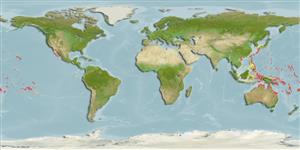>
Blenniiformes (Blennies) >
Blenniidae (Combtooth blennies) > Salariinae
Etymology: Blenniella: Diminutive of blennius, Greek,blenios = mucus (Ref. 45335).
More on authors: Bryan & Herre.
Environment: milieu / climate zone / depth range / distribution range
بوم شناسي
دريايي وابسته به آب سنگ; تغييرات عمق 0 - 3 m (Ref. 86942). Tropical
Western Pacific: southern Sulawesi; Palau to Marquesan and Ducie islands, north to Marcus Islands, south to Great Barrier Reef; throughout Micronesia; replaced by Blenniella periophthalmus in the Indian Ocean and southeast Asia from Ryukyus through Solomons to Santa Cruz Islands (Ref. 37816).
Size / Weight / سن
Maturity: Lm ? range ? - ? cm
Max length : 12.5 cm SL جنس نر / بدون خواص جنسي; (Ref. 9962); 13.1 cm SL (female)
خارهاي باله پشتي (کل) : 12 - 14; شعاع نرم باله پشتي (کل) : 18 - 21; خارهاي باله مخرجي: 2; شعاع نرم باله مخرجي: 20 - 21; مهره ها: 37 - 39. Diagnosis: Dorsal fin XII-XIV, 18-21, notched between spinous and segmented-ray portions; anal fin II, 20-21; pectoral rays 13-15 (usually 14); pelvic fin I, 3; caudal fin, procurrent rays 7, segmented rays 13. Vertebrae 12 + 25-27. Orbital cirrus simple and slender, may have a short lateral branch, less often up to 4 branches; nasal cirri short and palmate, may rarely have more than 6 branches; nuchal cirri simple and slender, may have a single branch or a ragged edge. Mandibular pores 6. Dorsal lips margin entire, ventral margin crenulated. Occipital crest absent, but large males have a low thin ridge (less than 1.8 mm); no crest or ridge in females (Ref. 9962).
Adults are common on exposed outer intertidal reef flats, in areas with numerous cracks and holes. They feed on filamentous algae and associated minute invertebrates, e.g., foraminiferans, ostracods, copepods, and gastropods (Ref. 37816). Oviparous. Eggs are demersal and adhesive (Ref. 205), and are attached to the substrate via a filamentous, adhesive pad or pedestal (Ref. 94114). Larvae are planktonic, often found in shallow, coastal waters (Ref. 94114).
Life cycle and mating behavior
بلوغ | تولید مثل | تخم ریزی | تخم ها | Fecundity | توزاد ( لارو)
Oviparous, distinct pairing (Ref. 205).
Springer, V.G. and J.T. Williams, 1994. The Indo-West Pacific blenniid fish genus Istiblennius reappraised: a revision of Istiblennius, Blenniella, and Paralticus, new genus. Smithson. Contrib. Zool. 565:1-193. (Ref. 9962)
وضعيت در فهرست قرمز IUCN (Ref. 130435: Version 2024-1)
خطر برای انسان ها
Harmless
استفاده انسانی
ابزارها
گزارش های ويژه
بارگيری XML
منابع اينترنتي
Estimates based on models
Preferred temperature (Ref.
123201): 24.7 - 29.4, mean 28.1 °C (based on 1052 cells).
Phylogenetic diversity index (Ref.
82804): PD
50 = 0.5020 [Uniqueness, from 0.5 = low to 2.0 = high].
Bayesian length-weight: a=0.00776 (0.00356 - 0.01695), b=3.00 (2.81 - 3.19), in cm total length, based on LWR estimates for this (Sub)family-body shape (Ref.
93245).
Trophic level (Ref.
69278): 3.1 ±0.40 se; based on food items.
جهندگی (Ref.
120179): زياد, كمينه زمان لازم براي دو برابر شدن جمعيت ، كمتر از 15 ماه (Preliminary K or Fecundity.).
Fishing Vulnerability (Ref.
59153): Low vulnerability (10 of 100).
Nutrients (Ref.
124155): Calcium = 132 [64, 212] mg/100g; Iron = 0.708 [0.398, 1.203] mg/100g; Protein = 18.4 [17.2, 19.5] %; Omega3 = 0.0771 [, ] g/100g; Selenium = 15.7 [7.3, 34.6] μg/100g; VitaminA = 149 [45, 491] μg/100g; Zinc = 2.01 [1.31, 2.90] mg/100g (wet weight);
